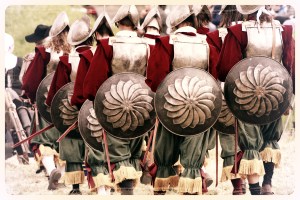I’ve been at this blogging thing for going on twelve years now, which is long enough to lose a little steam, and also to not always remember what territory I’ve already covered in this space. I am pretty sure, however, that in the first eleven years, I never once wrote specifically about chickens*. Now in year twelve, I have so far found myself writing about them twice.

It’s not that chickens aren’t fascinating creatures. I’m sure they are. I just never realized they held much of a significant role in history. That is until we all started thinking about the Roman Empire so much.
Actually, maybe you haven’t been thinking about the Roman Empire all that much lately. It started as an Instagram post turned Tik-Tok trend with a couple of Swedish influencers challenging women to ask the men in their lives how often they think about the Roman Empire. An oddly large percentage of men responded that they do think about the Roman Empire fairly often.
I’m a little late to the game because I don’t spend a great deal of time on either Instagram or Tik-Tok, but still several of the men in my life have played along and posted more than once that they are thinking about the Roman Empire again, which in turn makes me think about chickens.
Because chickens were pretty important to the Roman Empire, particularly the sacred chickens from the Greek Island of Euboea, whose opinions on foreign policy held great sway. Rightly so, because there was at least one incidence when their advice was not taken and disastrous results followed.
The story goes that during the First Punic War between Rome and Carthage, Roman consul and naval commander Publius Claudius Pulcher decided to attack the Carthaginian fleet at in the harbor of Drepana off the western coast of Sicily. As one evidently does while in Rome, he consulted the sacred chickens.
He asked his friendly neighborhood pullarius (Latin for chicken priest, just in case that ever comes up in conversation), who offered feed to the chickens and waited to see what would happen. If the chickens decided to eat, that would have been a sign of good luck. If not, then perhaps Pulcher would have been better off planning his attack for another day.

On this particular day, the chickens did not prove hungry, but Pulcher was not going to be told what to do by a bunch of bird-brained soothsayers. He allegedly responded to the chicken priest’s report that if the chickens didn’t want to eat, perhaps they could drink, and he ordered them all thrown overboard. He then went on to suffer the greatest naval defeat of the war and returned to Rome in shame.
It turns out that thinking about the chickens may be a worthwhile endeavor after all. If you spend much time thinking about the Roman Empire, they’re bound to come up eventually. Maybe even twice in only a few months.
I don’t know that I would say I spend an inordinate amount of time thinking about the Roman Empire, at least not as much as many of the men in my life apparently do. But I would bet that the time I spend writing blog posts about chickens is above average.
*After writing this post, it occurred to me that I did write about Mike the Headless Chicken once, back in June of 2016. You can begin to see why the topics are not coming as easily these days.





